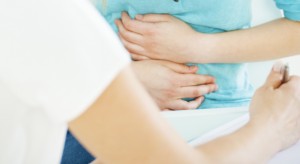In this case study, by Dr Fitzgerald (published by content partner IMCJ), she describes a teen patient, age 16, with symptoms of acute abdominal pain. The pain was in the lower right quadrant with ranging intensity from minimal to acute (2 to 10 on a visual analog scale (VAS), which interfered with her ability to attend school. Summary of case study, as written by Kara Fitzgerald, ND, Integrative Medicine, A Clinician’s Journal, Vol. 14, No 6.
 Dr Fitzgerald found the pain was not associated with reflux, a fever, or blood in her stools. A previous diagnosis of Eosinophilic esophagitis (EE) had been unsuccessfully treatment with a proton pump inhibitor (PPI). She presented anaphylactic reactions to raw apples and had evidence of significant food allergies to fruit, birch trees, weeds and pollen.
Dr Fitzgerald found the pain was not associated with reflux, a fever, or blood in her stools. A previous diagnosis of Eosinophilic esophagitis (EE) had been unsuccessfully treatment with a proton pump inhibitor (PPI). She presented anaphylactic reactions to raw apples and had evidence of significant food allergies to fruit, birch trees, weeds and pollen.
As Fitzgerald writes, “EE does not generally respond to antireflux therapy. Diagnosis is difficult, but key signs and symptoms are a lack of a favorable response to acid-blocking therapy and a history of allergic disease. Diagnosis can be confirmed with an esophageal biopsy, identifying eosinophil infiltration. Interventions include use of steroids and avoidance of trigger foods. A high degree of relapse exists with the condition because of poor dietary compliance.”1,2,3
In this case study, Fitzgerald reviews her protocols for treatment and how the patient’s pain was significantly reduced after a series of treatments that reduced the inflammation, address gut permeability and restored her microbiome.
Fitzgerald notes that the most common treatment for EE is steroidal therapy with removal of the offending foods. It is uncommon for physicians to get to the root cause of the disorder by reducing allergic bias and inflammation, balancing the gastrointestinal (GI) microbiome, and treating intestinal permeability. Her ideal goal was to restore the intestinal mucosa and reduce allergic bias, with the aim that certain foods could at some point be reintroduced and tolerated.
At the patient’s first visit, following tests were ordered: (1) a complete blood count (CBC), with a manual differential (5.6 [4.0-10.0]); (2) celiac profile (immunoglobulin A [IgA] total, antigliadin antibody, and tissue transglutaminase) (negative); (3) sedimentation rate (ESR) (normal); (4) C-reactive protein (CRP) (normal); (5) urinary analysis (UA) (normal); (6) complete metabolic panel (CMP) (normal); (7) vitamin D; (8) red blood count (RBC) essential elements; (9) ferritin; (10) microbiota imbalance (ie, a GI function stool test [GIfX]); and (11) food allergy and sensitivity panels for IgE (positive for wheat, rye, corn, rice, tomato, oat, orange, strawberry, apple, peach, grape, melon) and IgG4. The patient did not complete all of the lab work, including IgG4 food sensitivities panel, vitamin D, ferritin, RBC essential elements, and the stool test.
The patient was diagnosed with the following: (1) EE, (2) constipation, (3) atopic disease, (4) food and environmental allergies, (5) premenstrual syndrome, (6) intestinal permeability, and (7) possibly Eosinophilic gastroenteritis (EG).
As the full text of this study shows (download below) her symptoms were significantly reduced after a prescribed elimination diet based on IgE ELISA testing, prescribed probiotics, intestinal permeability combination formula, EPA/DHA, and vitamin D. Her pain was significantly reduced enough that she was able to return to school.
The protocol included the following:
1. An elimination diet based on the laboratory results for IgE and known allergens;
2. A 2.5 mL per day of a probiotic powder at 200-billion colony forming units (CFUs), mixed in juice or water;
3. A mixture of glutamine, zinc carnosine, slippery elm, and deglycyrrhizinated licorice (DGL), as directed, with the ability to mix it with juice or water;
4. Two capsules once per day of EPA/DHA 360/250; and
5. Two drops daily of vitamin D, at 2000 IU per drop.
Fitzgerald concludes, “Probably the most important thing to remember when working with teenagers is that the plan must be straightforward, and the teen must be in agreement with the approach. Although the author can think of a number of laboratory evaluations and treatment interventions that may have resulted in a fuller resolution, the patient was not willing to adhere to the entire plan. Without the patient’s cooperation, nothing can be accomplished.”
Sources:
-
Anton Remirez J, Escudero R, Caceres O, Fernandez-Benitez M. Eosinophilic esophagitis. Allergol Immunopathol (Madr). 2006;34(2):79-81.
-
Katzka DA. Eosinophilic esophagitis. Curr Opin Gastroenterol. 2006;22(4):429-432.
-
Noel RJ, Putnam PE, Rothenberg ME. Eosinophilic esophagitis. N Engl J Med. 2004;351(9):940-941.





